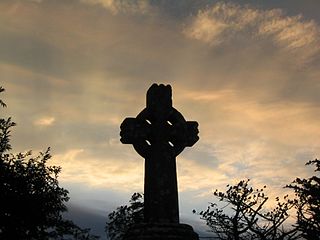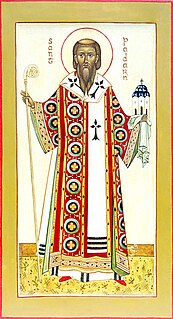Related Research Articles

Celtic Christianity is a form of Christianity that was common, or held to be common, across the Celtic-speaking world during the Early Middle Ages. Some writers have described a distinct Celtic Church uniting the Celtic peoples and distinguishing them from adherents of the Roman Church, while others classify Celtic Christianity as a set of distinctive practices occurring in those areas. Varying scholars reject the former notion, but note that there were certain traditions and practices present in both the Irish and British churches that were not seen in the wider Christian world.

Gildas — also known as Gildas the Wise or Gildas Sapiens — was a 6th-century British monk best known for his scathing religious polemic De Excidio et Conquestu Britanniae, which recounts the history of the Britons before and during the coming of the Saxons. He is one of the best-documented figures of the Christian church in the British Isles during the sub-Roman period, and was renowned for his Biblical knowledge and literary style. In his later life, he emigrated to Brittany where he founded a monastery known as St Gildas de Rhuys.
Ceredig ap Cunedda, was king of Ceredigion in Wales.

Cadfan ap Iago was King of Gwynedd. Little is known of the history of Gwynedd from this period, and information about Cadfan and his reign is minimal.
Einion ap Cunedda, also known as Einion Yrth, was a king of Gwynedd. He is claimed as an ancestor of the later rulers of North Wales.
Cadwallon ap Einion, usually known as Cadwallon Lawhir and also called Cadwallon I by some historians, was a king of Gwynedd. He was said to have been a son of Einion Yrth and Prawst ferch Deithlyn.

Saint Cadoc or Cadog was a 5th–6th-century Abbot of Llancarfan, near Cowbridge in Glamorgan, Wales, a monastery famous from the era of the British church as a centre of learning, where Illtud spent the first period of his religious life under Cadoc's tutelage. Cadoc is credited with the establishment of many churches in Cornwall, Brittany, Dyfed and Scotland. He is known as Cattwg Ddoeth, "the Wise", and a large collection of his maxims and moral sayings were included in Volume III of the Myvyrian Archaiology. He is listed in the 2004 edition of the Roman Martyrology under 21 September. His Norman-era "Life" is a hagiography of importance to the case for the historicity of Arthur as one of seven saints' lives that mention Arthur independently of Geoffrey of Monmouth's Historia Regum Britanniae.

Llanvaches or Llanfaches is a village and community parish within the boundaries of the city of Newport, Wales. It lies to the east of the urban area, in the historic county of Monmouthshire and the preserved county of Gwent. The population rose to 402 by the 2011 census.

Gwent was a medieval Welsh kingdom, lying between the Rivers Wye and Usk. It existed from the end of Roman rule in Britain in about the 5th century until the Norman conquest of England in the 11th century. Along with its neighbour Glywyssing, it seems to have had a great deal of cultural continuity with the earlier Silures, keeping their own courts and diocese separate from the rest of Wales until their conquest by Gruffydd ap Llywelyn. Although it recovered its independence after his death in 1063, Gwent was the first of the Welsh kingdoms to be overrun following the Norman conquest.

Saint Carantoc, also anglicized as Carantock, Carannog and by other spellings, was a 6th-century abbot, confessor, and saint in Wales and the West Country. He is credited with founding Llangrannog, Ceredigion, Wales and St Carantoc's Church, Crantock. His name is listed amongst the Cornish Saints. Carantoc's is one of five insular saints' lives and two Breton ones that mention Arthur in contexts that may be independent of Geoffrey of Monmouth's Historia Regum Britanniae. He is venerated by the Orthodox Church and Roman Catholic Church.
Peibo Clafrog, was King of Ergyng in south-east Wales in the 5th or 6th century. He is chiefly known from the legends of Saint Dubricius, who was supposedly his grandson. The contemporary rendering of this name would seem to be Peibio, as in Garthbeibio, a parish in Montgomeryshire, or Ynys Beibio, near Holyhead.
There is archaeological evidence of insular monasticism as early as the mid 5th century, influenced by establishments in Gaul such as the monastery of Martin of Tours at Marmoutier, the abbey established by Honoratus at Lérins; and that of Germanus at Auxerre. Many Irish monks studied at Candida Casa near Whithorn in Wales.

Gwynllyw Filwr or Gwynllyw Farfog, known in English in a corrupted form as Woolos the Warrior or Woolos the Bearded was a Welsh king and religious figure.

Padarn was an early 6th century sanctified British Christian abbot-bishop who founded St Padarn's Church in Ceredigion, Wales. The first bishop of Braga and Saint Paternus of Avranches in Normandy appear to be the same person. Padarn built a monastery in Vannes and is considered one of the seven founding saints of Brittany. Padarn's early vita is one of five insular and two Breton saints' lives that mention King Arthur independently of Geoffrey of Monmouth's Historia Regum Britanniae.
Caffo was a sixth-century Christian in Anglesey, north Wales, who is venerated as a saint and martyr. The son of a king from northern Britain who took shelter in Anglesey, Caffo was a companion of St Cybi, and is mentioned as carrying a red-hot coal in his clothes to Cybi without his clothes getting burnt. After leaving Cybi, Caffo was killed by shepherds in the south of Anglesey, possibly acting in retaliation for insults Caffo's brother had paid to the local ruler. The area where he died has a village, Llangaffo, named after him, as well as the parish church of St Caffo, Llangaffo.

St. Scuithin also known as Scolan, Scothin or Scuitin was a medieval Irish saint with strong Welsh connections. Sometime in the 6th century Scuthin left Ireland to pursue a life of cenobitic monasticism at Tyddewi in Wales founded by St. David, whom at a later date he is reported to have saved from poisoning.

William Jenkins Rees was a Welsh cleric and antiquary.
Saint Tathyw was a 5th-century saint of South Wales, and founder of a monastic school at Caerwent where he instructed many of the leading figures of the early Welsh church.
References
- ↑ Hando, F.J., (1958) "Out and About in Monmouthshire", R. H. Johns, Newport
- ↑ William Jenkins Rees, Lives of the Cambro British Saints (1853), Chapter V 'Life of Saint Tathan', page 591. Retrieved 2012-05-07.
- 1 2 William Jenkins Rees, "Lives of the Cambro British Saints" (1853), Chapter V 'Life of Saint Tathan', reproduced on Celtic Christianity website. Retrieved 2012-05-07.
- ↑ Pickering, W., Archaeologia Cambrensis, 1904